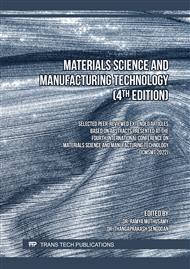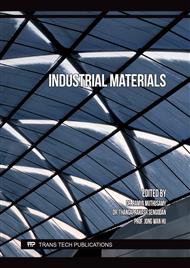p.33
p.39
p.47
p.53
p.61
p.67
p.79
p.89
p.107
Evaluation of Tensile and Flexural Properties of Unidirectional Glass-Epoxy Laminate with Aluminium Oxide and Magnesium Hydroxide as Filler Materials
Abstract:
Low weight is one of the most important factors in the design process of road and flight vehicles. The design engineers are careful with regards to the weight decrease without thinking twice about the primary strength. The composite is a lightweight material that has decent underlying properties and it is generally utilized. Fiber-supported polymer composites assumed a prevailing part for quite a while in an assortment of uses for their high explicit strength. The current work portrays the turn of events and the portrayal of another arrangement of GFRP. Experiments are carried out to study the effect of the addition of fillers by varying their percentages. The present work focus on the effect of the fillers on properties of Glass fiber epoxy laminates with aluminum oxide and magnesium hydroxide powders as the fillers. In the present work, fabrication and experimental investigation on unidirectional glass epoxy composites are carried out. Initially, glass fiber reinforced polymer laminate fabricated without filler material, hand layup followed by vacuum bagging methods are used . Then, by adding Aluminium oxide and Magnesium hydroxide as a filler material with different percentages like 5%, 10%, and 15% by weights and laminates are fabricated and experimental investigation is conducted to study their mechanical behavior. The comparative studies on the laminates are carried out and the obtained results are analyzed and those are quite interesting.
Info:
Periodical:
Pages:
61-66
Citation:
Online since:
November 2022
Authors:
Keywords:
Price:
Сopyright:
© 2022 Trans Tech Publications Ltd. All Rights Reserved
Share:
Citation:



